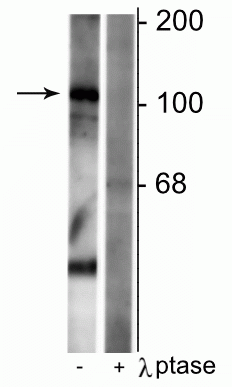Anti-GABAB Receptor (Ser923), R1-Subunit Antibody
Our Anti-GABAB Receptor (Ser923), R1-Subunit rabbit polyclonal phosphospecific primary antibody from
- SPECIFICATION
- CITATIONS
- PROTOCOLS
- BACKGROUND

| Primary Accession | Q9Z0U4 |
|---|---|
| Host | Rabbit |
| Clonality | Polyclonal |
| Isotype | IgG |
| Calculated MW | 108204 Da |
| Gene ID | 81657 |
|---|---|
| Other Names | dJ271M21.1.1 antibody, dJ271M21.1.2 antibody, FLJ92613 antibody, GABA-B receptor 1 antibody, GABA-B-R1 antibody, GABA-BR1 antibody, GABAB R1 antibody, GABAB subunit 1c antibody, GABABR1 antibody, GABBR1 3 antibody, GABBR1 antibody, GABR1_HUMAN antibody, Gamma aminobutyric acid (GABA) B receptor 1 antibody, Gamma-aminobutyric acid type B receptor subunit 1 antibody, Gb1 antibody, GPRC3A antibody, Seven transmembrane helix receptor antibody |
| Target/Specificity | Gamma-aminobutyric acid (GABA) is the primary inhibitory neurotransmitter in the central nervous system. There are two major classes of GABA receptors: the GABA-A and the GABA-B subtype of receptors. GABA-B receptors are heterodimeric G protein-coupled receptors that mediate slow synaptic inhibition in the central nervous system. Phosphorylation enhances GABA-B receptor effector coupling (Couve et al., 2004). Phosphorylation of Ser-923 is thought to be important in the regulation of GABA-B receptor function. |
| Format | Antigen Affinity Purified from Pooled Serum |
| Storage | Maintain refrigerated at 2-8°C for up to 6 months. For long term storage store at -20°C in small aliquots to prevent freeze-thaw cycles. |
| Precautions | Anti-GABAB Receptor (Ser923), R1-Subunit Antibody is for research use only and not for use in diagnostic or therapeutic procedures. |
| Shipping | Blue Ice |

Thousands of laboratories across the world have published research that depended on the performance of antibodies from Abcepta to advance their research. Check out links to articles that cite our products in major peer-reviewed journals, organized by research category.
info@abcepta.com, and receive a free "I Love Antibodies" mug.
Provided below are standard protocols that you may find useful for product applications.
Background
Gamma-aminobutyric acid (GABA) is the primary inhibitory neurotransmitter in the central nervous system. There are two major classes of GABA receptors: the GABA-A and the GABA-B subtype of receptors. GABA-B receptors are heterodimeric G protein-coupled receptors that mediate slow synaptic inhibition in the central nervous system. Phosphorylation enhances GABA-B receptor effector coupling (Couve et al., 2004). Phosphorylation of Ser-923 is thought to be important in the regulation of GABA-B receptor function.
If you have used an Abcepta product and would like to share how it has performed, please click on the "Submit Review" button and provide the requested information. Our staff will examine and post your review and contact you if needed.
If you have any additional inquiries please email technical services at tech@abcepta.com.













 Foundational characteristics of cancer include proliferation, angiogenesis, migration, evasion of apoptosis, and cellular immortality. Find key markers for these cellular processes and antibodies to detect them.
Foundational characteristics of cancer include proliferation, angiogenesis, migration, evasion of apoptosis, and cellular immortality. Find key markers for these cellular processes and antibodies to detect them. The SUMOplot™ Analysis Program predicts and scores sumoylation sites in your protein. SUMOylation is a post-translational modification involved in various cellular processes, such as nuclear-cytosolic transport, transcriptional regulation, apoptosis, protein stability, response to stress, and progression through the cell cycle.
The SUMOplot™ Analysis Program predicts and scores sumoylation sites in your protein. SUMOylation is a post-translational modification involved in various cellular processes, such as nuclear-cytosolic transport, transcriptional regulation, apoptosis, protein stability, response to stress, and progression through the cell cycle. The Autophagy Receptor Motif Plotter predicts and scores autophagy receptor binding sites in your protein. Identifying proteins connected to this pathway is critical to understanding the role of autophagy in physiological as well as pathological processes such as development, differentiation, neurodegenerative diseases, stress, infection, and cancer.
The Autophagy Receptor Motif Plotter predicts and scores autophagy receptor binding sites in your protein. Identifying proteins connected to this pathway is critical to understanding the role of autophagy in physiological as well as pathological processes such as development, differentiation, neurodegenerative diseases, stress, infection, and cancer.


